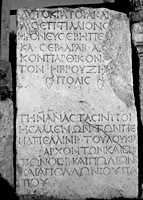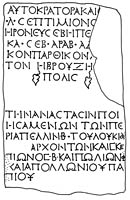 MAMA XI 136 (Pentapolis)
MAMA XI 136 (Pentapolis) 
Honorific statue-base for Septimius Severus
- Type of monument:
- Honorific statue-base.
- Location:
- Karasandıklı (Pentapolis): outside the mosque.
- Description:
- Greyish-white marble block, unmoulded.
- Dimensions:
- Ht. 0.90; W. 0.50; Th. 0.50; letters 0.030.
- Record:
- Partial squeeze (ll. 5-7); line drawing; MB notebook copy; photograph (1955/38).
- Publication:
- Ramsay 1882: 514-5, no. 1; [Ramsay, Phrygia II 700, no. 634; IGR IV 681].
- Date:
- AD 198-210 (imperial titles)
Αὐτοκράτορα Καίσ̣[αρα]
Λ(εύκιον) · Σεπτίμιον Σ̣[εου]-
ῆρον Εὐσεβῆ Πε[ρτίνα]-
κα · Σεβ(αστὸν) · Ἀραβ(ικὸν) · Ἀδ[ιαβηνι]-
5κὸν Παρθικὸν Μ̣[έγισ]-
τον · ἡ Βρουζη[νῶν]
hed. πόλις hed.
vac.
τὴν ἀνάστασιν ποι-
ησαμένων τῶν πε-
10ρὶ Ἄπελλιν β´ · τοῦ Λουκίου
vac. ἀρχόντων καὶ Σκε-
πίωνος β´ καὶ Πωλίωνος
καὶ Ἀπολλωνίου Πα-
πιου.
The city of the Brouzenoi (honoured) Imperator Caesar Lucius Septimius Severus Pius Pertinax Augustus Arabicus Adiabenicus Parthicus Maximus. The board of archontes over whom Apellis son of Apellis, grandson of Lucius presided were responsible for the erection (of the statue) ⟨and Scipio son of Scipio and Pollio and Apollonios Papias⟩.






This monument, a statue base of the emperor Septimius Severus, constitutes our only evidence for the location of Brouzos at Kara Sandıklı (Ramsay 1882: 503-5; TIB Phrygien 215; Cohen 1995: 292-3). The emperor’s titulature dates the monument to the period AD 198-210 (Kienast 1996: 156-8).
The erection of the statue was the responsibility of the college of archontes at Brouzos, described as τῶν περὶ Ἀπέλλιν β´ τοῦ Λουκίου ἀρχόντων (lines 9-11). For the phrase οἱ περὶ τὸν δεῖνα ἄρχοντες as a means of denoting the archon-college in Phrygia, compare e.g. IGR IV 686 (Sebaste); IGR IV 567 (Aizanoi); for the expression οἱ περί + acc., Dow 1960: 395-7. At Synnada and Alia, the president of the archon-college was regularly known as the πρῶτος ἄρχων, and the board was given the fuller title of οἱ περὶ τὸν δεῖνα πρῶτον ἄρχοντα ἄρχοντες: MAMA IV 59, 63; MAMA VI 378; SEG 28, 1209 (all Synnada); SEG 41, 1174 (Alia). To all appearances, the archon-college at Brouzos consisted of at least four men, as at the neighbouring cities of Orkistos (MAMA VII 304) and Otrous (IGR IV 693): boards of at least five men are attested at both Apameia-Kelainai (IGR IV 792) and Synnada (IGR IV 704).
The word ἀρχόντων in line 11 is placed at the centre of the line and preceded by a vacat, suggesting that the inscription originally ended here. Three other members of the board of archontes subsequently insisted that their names should also appear on the monument, presumably since they had helped pay for the statue (Ramsay, Phrygia II 700); their names are inscribed in a different hand. For a parallel, cf. Robert, Hellenica VII, 197-205, with BE 1965, 210: a statue has been set up by a professional association at Tarsos ‘under the board of grammateis over whom Neon presided, for the second time’ (ἐπὶ γραμματέων τῶν περὶ Νέωνα τὸ β´, lines 14-15); the text then goes on, unusually, to name all the other members of the board (καὶ Λούκιον τὸ β´ καὶ Ἀλέξανδρον τὸ β´ καὶ Μυραγένην τὸ β´, lines 15-16); the text concludes by recording that ‘the same grammateis dedicated the statio to the sacred association from their own funds’ (οἱ αύτοὶ γραμματεῖς τὴν στατίωνα ἐκ τῶν ἰδίων τῷ ἱερῷ συνεργίω, lines 16-17). Although the name of the presiding grammateus alone would have sufficed as a dating mechanism, since the whole board of grammateis had contributed financially, all members wanted their names to appear on the stele; compare MAMA XI 103 (1956/69: Akmoneia).
The name of the president of the board of archontes, Ἄπελλις (Masson, OGS III 168-70) is exceptionally rare in the Roman imperial period. but the reading is not in doubt. In the Hellenistic period, the name is attested at Priene (I.Priene 4), Philippoi (LGPN IV, s.v.), and Hierapolis in Syria (SEG 48, 1861). The phonetic confusion Σκεπίων (lines 11-12) for Latin Scipio is well-attested in Anatolian epigraphy in the Roman imperial period. see Brixhe 1987: 54 (Δομετία, ὠρδεναρίου, Βρεττανικόν etc.). For the orthography of the name Πωλίων, see the commentary to MAMA XI 100 (1955/97: Akmoneia). For the name Παπιας (not, as Ramsay, Παπας), see Zgusta 1964: 409-12.